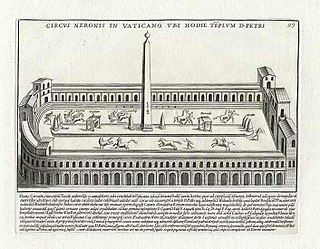
The so-called Circus of Nero or Circus of Caligula was a circus in ancient Rome, located mostly in the present-day Vatican City.

Trastevere is the 13th rione of Rome, Italy. It is identified by the initials R. XIII and it is located within Municipio I. Its name comes from Latin trans Tiberim.

The Servian Wall is an ancient Roman defensive barrier constructed around the city of Rome in the early 4th century BC. The wall was built of volcanic tuff and was up to 10 m (33 ft) in height in places, 3.6 m (12 ft) wide at its base, 11 km (6.8 mi) long, and is believed to have had 16 main gates, of which only one or two have survived, and enclosed a total area of 246 hectares. In the 3rd century AD it was superseded by the construction of the larger Aurelian Walls as the city of Rome grew beyond the boundary of the Servian Wall.

The Meta Sudans was a large monumental conical fountain in ancient Rome.
The Arch of Tiberius was a triumphal arch built in 16 AD in the Forum Romanum to celebrate the recovery of the eagle standards that had been lost to Germanic tribes by Varus in 9 AD. The Roman general Germanicus had recovered the standards in 15 or 16 AD.
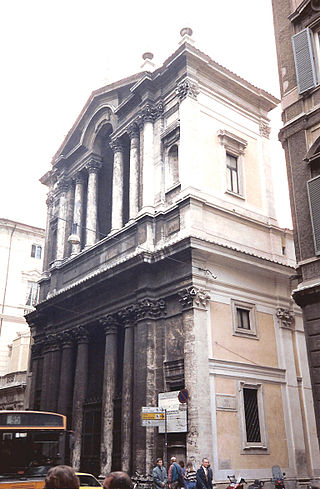
Santa Maria in Via Lata is a church on the Via del Corso, in Rome, Italy. It stands diagonal from the church of San Marcello al Corso. It is the stational church for Tuesday in the fifth week of lent.

The Insula dell'Ara Coeli is one of the few surviving examples of an insula, the kind of apartment blocks where many Roman city dwellers resided. It was built during the 2nd century AD, and rediscovered, under an old church, when Benito Mussolini initiated a plan for massive urban renewal of Rome's historic Capitoline Hill neighbourhood.
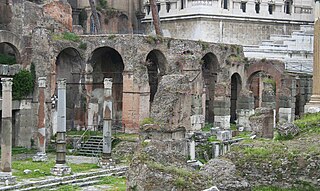
The Basilica Argentaria is a portico with pillars lining the Temple of Venus Genetrix in the Forum of Caesar in Rome (Italy). The name only appears in late sources of the age of Constantine.

Porticus Aemilia was a portico in ancient Rome. It was one of the largest commercial structures of its time and functioned as a storehouse and distribution center for goods entering the city via the Tiber river.
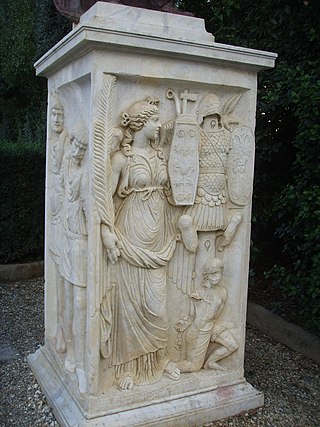
The Arcus Novus was an ancient arch in Rome, located on the Via Lata, at the site of the church of Santa Maria in Via Lata.
The Temple of Pudicitia Plebeia was an ancient Roman temple on the Quirinal Hill, along the Vicus Longus, on what is now via Nazionale. It was dedicated to 'plebeian chastity' and built in 296 BC by Virginia, wife of the future consul Lucius Volumnius, in a section of her own house.

The Sant'Omobono Area is an archaeological site in Rome next to the church of Sant'Omobono, at the junction of via L. Petroselli and the Vico Jugario at the foot of the Campidoglio. It was discovered in 1937 and contains much important evidence for archaic and republican Rome. It contains altars and the sites of the temple of Fortuna and the temple of Mater Matuta. An earlier archaic-period temple underlies these two, dating itself to the early 6th century BCE, making it the oldest known temple remains in Rome.

The Temple of Jupiter Custos was a minor temple in Rome, probably on the Capitoline Hill. It was built by Domitian in memory of his narrow escape from the Capitol during Vitellius' siege. Its site is uncertain – some scholars place it on the rectangular podium in opus caementicium with basalt chips discovered in the 19th century during the construction of via del Tempio di Giove. However, that rectangular plan does not seem compatible with a temple, which a relief in the Palazzo dei Conservatori places to the right of the Temple of Jupiter Optimus Maximus.
The Temple of Ops was a minor temple on the Capitoline Hill in Rome. It was dedicated to Ops, the deity of abundance.
The Sanctuary of Ceres, Liber and Libera was a temple to Ceres, Liber Pater and Libera built on the Aventine Hill in Rome. It was dedicated in 494 BC. The temple was destroyed by fire in 31 BC, but was repaired. It was still in function in the 4th-century, but would have been closed during the persecution of pagans in the late Roman Empire.
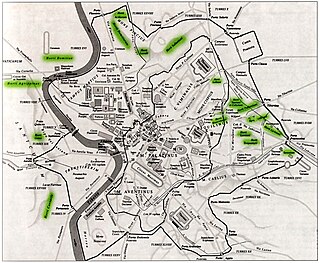
The Horti Agrippinae was a luxurious villa-estate belonging to Agrippina the Elder in ancient Rome. It was located on the west bank of the river Tiber where St. Peter's Basilica is now, and extended to the river where a terrace with a portico was built.

The Basilica Opimia was one of four Republican-era basilicas in the Roman Forum. The other two were the Basilica Aemilia, the Basilica Porcia, and the Basilica Sempronia. Of the three, only the Basilica Aemilia partially survives.

The Temple of Flora was an ancient sanctuary on the Quirinal Hill in Ancient Rome, erected in 238 BCE and dedicated to the goddess Flora.
The Temple of Salus was an sanctuary in Ancient Rome dedicated to the goddess Salus. The temple was founded by Gaius Junius Bubulcus in 306-303 BC. If still in use by the 4th-century, it would have been closed during the persecution of pagans in the late Roman Empire.
The Settecamini archaeological area is in the Settecamini district on the eighth mile of the ancient via Tiburtina Valeria from central Rome. It was discovered in 1951. It is at the halfway point between Rome and Tivoli and crosses the road from the River Aniene to Etruria and Sabina.